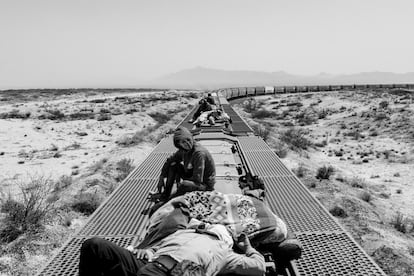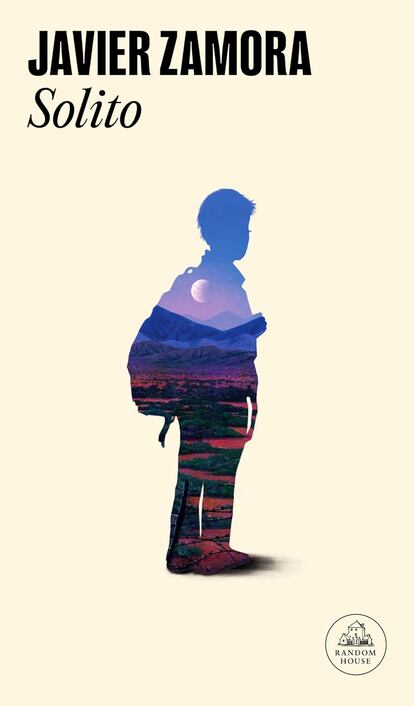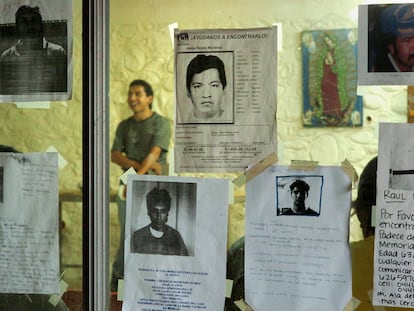The story of a harrowing migration journey through the eyes of a child
‘Solito: A Memoir’ by Javier Zamora is a bestseller about his dangerous odyssey from El Salvador to rejoin his parents in the US


In 1999, he left his small hometown in El Salvador where he lived with his grandparents, and embarked on an arduous 3,100-mile (5,000-kilometer), nine-week journey to the United States. He braved a treacherous boat voyage from Guatemala to Mexico and crossed the suffocating Sonoran Desert on foot to reach Arizona. Accompanied by strangers, entrusted to coyotes and polleros (people smugglers, in English), he journeyed north on boats, trains, buses and trucks. He used fake identities, evaded soldiers, mimicked local accents, and embraced the “migrant” label — a word he had never associated with himself until then. Along the way, some of his fellow travelers perished and vanished, but the boy managed to survive. He aimed to reunite with his parents in California, where they had settled after fleeing their war-torn homeland years ago. Javier Zamora was only nine years old at the time.
Now 33, Zamora narrates his harrowing journey in Solito: A Memoir (Random House Group, 2022), a New York Times bestseller and a Jenna Bush Hager Book Club pick. “There’s been so much talk about migrant children, but it’s always from the perspective of adults. It’s actually easier to listen to what a child has to say... That’s why I think this book is really successful,” said Zamora, in a video call from Tucson.
Tucson was where he arrived 25 years ago after his journey from El Salvador. After a long time away, he has returned to settle there. During the pandemic, he attempted to write Solito in a small New York apartment, but had a hard time capturing the mood — the big city wasn’t for him. He went to Tucson with his partner, planning to only stay for two weeks. “We’ve been here for four years now. At first, I was scared of coming back here because it brought me nothing but suffering. But you know what? Day by day, we’ve managed to create some really great memories. It’s like we’re slowly erasing all the trauma.”

What sets Solito apart is the child’s perspective on the journey. Rather than approaching it as an odyssey, Zamora embraces it with a sense of wonder. He finds amazement in the places he discovers, the people who accompany him, and the adventures he experiences. His curiosity and humor shine through, as he truly embodies the essence of a child. This is not just a migration, but a transformative voyage, a quest for knowledge and growth. “I think it’s like a defense mechanism. Because I sensed that something big was happening, but instead of fixating on that, my brain was thinking about nature, music, food and other stuff,” said Zamora, who narrates the journey with high-definition descriptions. He says this method helped to express and process the trauma. “I thought that the more details I put in, the better the healing would be.”
Coyotes — the guides who lead migrants to the U.S. border — play a big role in Zamora’s book. While they are typically depicted in fiction as unscrupulous villains, in Solito they have a certain humanity, and some like Don Dago are part of the community. “Don Dago helped many people leave the country,” said Zamora, “but back then the cartels weren’t involved in the migration business. That changed in the early 2000s and I can tell you that coyotes like the ones in my book no longer exist. Now they have bosses who are drug traffickers.”
The inner journey
The journey theme has been deeply ingrained in the history of literature since its earliest beginnings, as seen in ancient works like the Sumerian epic of Gilgamesh and Homer’s The Odyssey. Among all the types of journeys, migration stands out as one that carries immense emotional weight. It’s a journey where people are often forced to leave behind their homelands and loved ones in search of safer, better lives. Tragically, they often face rejection from those who await them in their destination. Perhaps that’s why we have so many firsthand accounts during the current “immigration crisis.”
In his Spanish-language book The Moon is in Duala: and My Destiny, in Knowledge (Plaza y Janés, 2023), Sani Ladan narrates his journey as a 15-year-old to gain an education that was impossible in his native country of Cameroon. He dreamed of becoming a journalist, so for a year he secretly saved money for his trip to Europe. Boko Haram terrorists, human trafficking gangs, and European immigration officials failed to deter Ladan, who ultimately made it to Spain through Ceuta, a Spanish exclave city bordering Morocco on the north coast of Africa.

Ousman Umar, a Ghanaian, shared a similar yet distinct journey in another Spanish-language novel, Voyage to the Country of the Whites (Plaza y Janés, 2019). Umar was also nine like Javier Zamora when he embarked on a boat journey to Spain’s Canary Islands that took five years. Along the way, he ran into dangerous gangs, endured hunger and hardships in Libya, and crossed the treacherous Sahara desert. Only two people survived out of the 40 that started the journey with Umar. Other books in Spanish with personal migration stories include Three Days in the Sand (La Imprenta, 2021) by Ibrahim Bah from Guinea, and 3052. Chasing a Dream (Punto Rojo, 2013) by Mamadou Día from Senegal. Ladan and Umar, who faced near-death experiences and endured Spain’s Foreigner Detention Centers (CIE), are inspiring success stories. They seamlessly integrated into Spain, pursued higher education, and now have a powerful voice to share their stories.
Javier Zamora is an American success story. As an aspiring poet, he won scholarships from prestigious universities like Harvard and Stanford. Writing became his outlet for dealing with trauma. At first, he resisted coming to terms with the pain he experienced as a migrant. However, as he reached adolescence, his past began to resurface. One of his first literary attempts to deal with his past was his first poetry collection, Unaccompanied, published in 2017 by Copper Canyon Press. “That’s the kind of book you write when you haven’t been to therapy,” said Zamora. “Solito is what came out when I started writing while going to therapy and with the support of a partner.”
Zamora got his start in poetry when his language teacher introduced him to Chilean poet Pablo Neruda and he read Twenty Love Poems and a Song of Despair. “Neruda wrote it when he was really young, around the same age as me, and it’s one of the most well-known poetry collections out there. Plus, it reminds me of my homeland.” Like so many others before him, Zamora was inspire to write verse by the Chilean poet. In Unaccompanied, Zamora included a quote from from the Serbian-born American poet Charles Simic, who died just a year ago. “He was born in Serbia and won a Pulitzer, so he became a role model for me,” said Zamora. A role model that would be joined by June Jordan and Salvadoran poets such as Roque Dalton and Claribel Alegría. Another American immigrant with a Pulitzer (in fiction) is Junot Díaz, who won for The Brief Wondrous Life of Oscar Wao (Penguin Group, 2007), another book about the migration experience by a humorous, mixed-race Dominican who settled in New Jersey.
Zamora experienced extreme situations similar to those of Mediterranean migrants: a terrifying 20-hour boat trip from Guatemala to Mexico. Shipwrecks were not uncommon, and they endured fear, seasickness, and the unrelenting noise and nauseating smell of diesel engines. The desert journey was plagued by the constant fear of getting caught by La Migra (U.S. border police). However, Zamora says the most emotional part of the trip was leaving some of the people who accompanied him. “Saying goodbye to Chino, Patricia, Carla... It always makes me cry... Losing the only three people who truly understood everything I’ve been through... Two of them were adults. I wonder how they remembered it as grown-ups. I can only imagine how terrifying it must have been.”
Other perspectives
Migration stories are not always told in the first-person point of view. Canto per Europa (Song for Europe, in English), is an epic, Homeric poem written in Italian by Paolo Rumiz about the adventures of a Syrian refugee and the modern Argonauts who pick her up in the ocean. Together, the ship sets off to discover the true meaning of Europe. For Rumiz, migration is not just a transitory crisis, but an enduring condition of the European continent that we need to comprehend. “It’s unfortunate that in modern times, we often overlook the context and fail to grasp the significance of history,” said Rumiz in a recent interview with EL PAÍS. Another journey from Syria is Hakim’s Odyssey (Graphic Mundi, 2021) a graphic novel by Fabian Toulmé about the real-life adventures of a young Syrian who leaves his war-ravaged country and family hoping to find a future in Lebanon, Jordan and then Turkey. Another graphic novel, El cielo en la cabeza (The Sky in the Head, in English), by Antonio Altarriba and Sergio García is about a child who migrates to Spain after escaping the African coltan mines that produce those all important minerals for our smartphones.
My Fourth Time, We Drowned by Irish journalist Sally Hayden, is a story that begins when she receives a plea for help on Facebook from an Eritrean refugee in a Libyan detention center. The story that unfolds about the migration crisis in North Africa sheds light on the plight of hundreds of refugees trapped in Libya while attempting to reach Europe.

The purpose of literature
“People aren’t really interested in migration anymore,” said Zamora. “There was a time around 2016 when people were more interested, but that wasn’t even the biggest wave of migration. Actually, more people arrived back in 1999, when I first got here.” He believes that interest in migration is often driven by politics. Trump brings it up in campaign speeches, and the progressive media also leverages it to criticize Trump. However, it tends to get forgotten afterwards. With the upcoming U.S. elections, Zamora predicts that the issue will resurface.
Why do we spill so much ink discussing migration? Does it serve any purpose? “I wrote Solito for myself, you know, to heal, but also so that other folks’ hearts can heal too. And so that they learn to have empathy,” said Zamora. In El Salvador, the “Committed Generation” refers to a group of writers from the 1950s who strongly believed in the connection between art, literature and political and social commitment.
Zamora’s native country often makes headlines due to its young president, Nayib Bukele, who has implemented controversial policies such as adopting Bitcoin as legal tender and his iron-fisted approach to eradicating gang violence. Zamora sees significant changes ahead for his country but chooses not to offer any opinions. His silence speaks volumes. “We need to dream of a world we don’t have yet. In 2024, people still don’t see migrants as complete human beings. We’re just migrants, defined only by what we’ve suffered. But we’re also people who are contributing to this world.”
Sign up for our weekly newsletter to get more English-language news coverage from EL PAÍS USA Edition
Tu suscripción se está usando en otro dispositivo
¿Quieres añadir otro usuario a tu suscripción?
Si continúas leyendo en este dispositivo, no se podrá leer en el otro.
FlechaTu suscripción se está usando en otro dispositivo y solo puedes acceder a EL PAÍS desde un dispositivo a la vez.
Si quieres compartir tu cuenta, cambia tu suscripción a la modalidad Premium, así podrás añadir otro usuario. Cada uno accederá con su propia cuenta de email, lo que os permitirá personalizar vuestra experiencia en EL PAÍS.
¿Tienes una suscripción de empresa? Accede aquí para contratar más cuentas.
En el caso de no saber quién está usando tu cuenta, te recomendamos cambiar tu contraseña aquí.
Si decides continuar compartiendo tu cuenta, este mensaje se mostrará en tu dispositivo y en el de la otra persona que está usando tu cuenta de forma indefinida, afectando a tu experiencia de lectura. Puedes consultar aquí los términos y condiciones de la suscripción digital.
More information
Archived In
Últimas noticias
Most viewed
- Sinaloa Cartel war is taking its toll on Los Chapitos
- Oona Chaplin: ‘I told James Cameron that I was living in a treehouse and starting a permaculture project with a friend’
- Reinhard Genzel, Nobel laureate in physics: ‘One-minute videos will never give you the truth’
- Why the price of coffee has skyrocketed: from Brazilian plantations to specialty coffee houses
- Silver prices are going crazy: This is what’s fueling the rally










































